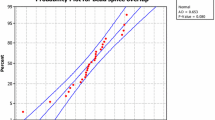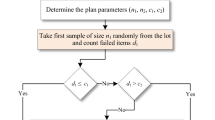Abstract
Goal and Background
Uncertainty is commonly not taken into account in LCA studies, which downgrades their usability for decision support. One often stated reason is a lack of method. The aim of this paper is to develop a method for calculating the uncertainty propagation in LCAs in a fast and reliable manner.
Approach
The method is developed in a model that reflects the calculation of an LCA. For calculating the uncertainty, the model combines approximation formulas and Monte Carlo Simulation. It is based on virtual data that distinguishes true values and random errors or uncertainty, and that hence allows one to compare the performance of error propagation formulas and simulation results. The model is developed for a linear chain of processes, but extensions for covering also branched and looped product systems are made and described.
Results
The paper proposes a combined use of approximation formulas and Monte Carlo simulation for calculating uncertainty in LCAs, developed primarily for the sequential approach. During the calculation, a parameter observation controls the performance of the approximation formulas. Quantitative threshold values are given in the paper. The combination thus transcends drawbacks of simulation and approximation.
Conclusions and Outlook
The uncertainty question is a true jigsaw puzzle for LCAs and the method presented in this paper may serve as one piece in solving it. It may thus foster a sound use of uncertainty assessment in LCAs. Analysing a proper management of the input uncertainty, taking into account suitable sampling and estimation techniques; using the approach for real case studies, implementing it in LCA software for automatically applying the proposed combined uncertainty model and, on the other hand, investigating about how people do decide, and should decide, when their decision relies on explicitly uncertain LCA outcomes-these all are neighbouring puzzle pieces inviting to further work.
Similar content being viewed by others
References
Kahnemann D, Slovic P, Tversky A (Eds) (1982): Judgement under Uncertainty, Heuristics and Biases. Cambridge University Press
Ciroth A (2003): Uncertainty calculation for LCI data: Reasons for, against, and an efficient and flexible approach for doing it. Presentation, International Workshop on Quality of LCI Data, 20–21 October 2003, Forschungszentrum Karlsruhe http://www.lci-network.de/cms/content/cache/offonce/pid/468
http://www.spold.org/
http://www.globalspine.com/LCA/
Weidema B, Wesnaes MS (1996): Data quality management for life cycle inventories-An example for using data quality indicators. J Cleaner Prod 4 (3-4) 167–174
Huijbregts MAJ, Norris G, Bretz R, Ciroth A, Maurice B, von Bahr B, Weidema B, de Beaufort ASH (2001): Framework for Modelling Data Uncertainty in Life Cycle Inventories. Int J LCA 6 (3) 127–131
Huijbregts MAJ (2001): Uncertainty and variability in environmental life-cycle assessment. Academisch Proefschrift, Univ. van Amsterdam, Amsterdam
Ciroth A (2000): A new model for the propagation of errors in LCA, shown in a case study. Platform Presentation, 8th SETAC case study symposium, Brussels
Canter KG, Kennedy DJ, Montgomery DC, Keats JB, Carlyle WM (2002): Screening Stochastic Life Cycle Assessment Inventory Models. Int J LCA 7 (1) 18–26
Le Téno JF (1999): Visual Data Analysis and Decision Support Models for Non-Deterministic LCA. Int J LCA 4 (1) 41–47
Pohl Chr, Ros M (1996): Sind Ökobilanzen zu präzise? In: Intelligente Methoden zur Verarbeitung von Umweltinformation. 2. Bremer KI-Pfingstworkshop (Tagungsband), metropolis, Marburg, pp 121–136
Heijungs R (1996): Identification of key issues for further investigation in improving the reliability of life-cycle assessments. J Cleaner Prod 4 (3-4) 159–166
Sangwon Suh (2003): personal communication, 11 June 03
Ecospold data format http://www.ecoinvent.org/en/pdf/Documentation EcoSpoldl,2.pdf
McCleese D, LaPuma P (2002): Using Monte Carlo Simulation in Life Cycle Assessment for Electric and Internal Combustion Vehicles. Int J LCA 7 (4) 230–236
Ciroth A (2001): Fehlerrechnung in Ökobilanzen. Dissertation TU Berlin 2001 http://edocs.tu-berlin.de/diss/2001/ciroth andreas.htm
Bevington R, Robinson DK (1992): Data Reduction and Error Analysis for the Physical Sciences. WCB/McGrawHill, Boston
Bacchini P, Bader HP (1996): Regionaler Stoffhaushalt. Spektrum Akademischer Verlag, Heidelberg Berlin Oxford
Wolf H (1979): Ausgleichungsrechnung H. Ferd. Dummlers Verlag, Bonn
Höpcke W (1980): Fehlerlehre und Ausgleichsrechnung, Walter de Gruyter, Berlin New York
Vose D (1996): Quantitative Risk Analysis: A Guide to Monte Carlo Simulation Modelling. John Wiley & Sons, Chichester, New York, Brisbane, Toronto, Singapore
Fleischer G, Schmidt WP (1995): Life cycle assessment. In: Ullmann’s Encyclopedia of Industrial Chemistry, 5th Ed, Vol B8, Weinheim: VCH Verlagsgesellschaft, pp 585–600
Schmidt M (1996): Die Modellierung von Stoffrekursionen in Ökobilanzen. In: [24, pp 97–117]
Schmidt M, Schorb A (1996): Stoffstromanalysen in Ökobilanzen und Öko-Audits. Springer Verlag, Berlin Heidelberg
Moller A, Rolf A, Page B, Wohlgemuth V (2001): Foundations and Applications of Computer Based Material Flow Networks for Environmental Management. In: Rautenstrauch C Patig S (Eds) Environmental Information Systems in Industry und Public Administration. Hershey, PA USA, pp 379–396
Ciroth A (1998): Beispielhafte Anwendung der Iterativen Screening-Ökobilanz. Master thesis, Fachgebiet Abfallvermeidung der TU Berlin, Berlin
Heijungs R, Suh S (2002): The computational Structure of Life Cycle Assessment. Kluwer Academic Publishers, Dordrecht
Hertwich EG, Hammitt JK (2001): A Decision-Analytic Framework for Impact Assessment, Part 2: Midpoints, Endpoints, and Criteria for Method Development. Int J LCA 6 (5) 265–272
Matlab Function Reference; Function ‘inv’, Version 6.5, Release 13, 2002
Golub G, Ortega JM (1993): Scientific Computing. Academic Press
Ciroth A (2000): Einfluß der Reihenfolge von Bezugsszenariorechnung, Normierung und Charakterisierung auf das Ergebnis der LCA. In: Umweltschutz im neuen Jahrhundert, Festschrift anlässlich des 60. Geburtstages von Univ.-Prof. Dr.-Ing. Günter Fleischer, TK Verlag, Neuruppin, pp 95–104
Ross St, Evans D, Webber M (2002): How LCA Studies Deal with Uncertainty. Int J LCA 7 (1) 47–52
Plinke E, Schonert M, Meckel H, Detzel A, Giegrich J, Fehrenbach H, Ostermayer A, Schorb A, Heinisch J, Luxenhofer K, Schmitz St, Umwelt-bundesamt (Hrsg) (2000): Ökobilanz für Getränkeverpackungen II, Hauptteil. UBA Texte 37/00, Berlin 2000, p 133: ‘Eine spezielle Methode zur Fehlerabschätzung in Ökobilanzen wurde bislang nicht entwickelt’ (a specific method for estimating uncertainties in LCAs is not developed yet)
GaBi 4 Reference manual, 2003-01-29
Björklund AE (2002): Survey of Approaches to Improve Reliability in LCA. Int J LCA 7 (2) 62–72
Tukey JW (1977): Exploratory Data Analysis, Addison Wesley, Reading
Ackermann R (1997): Ableitung von allgemein nutzbaren Sachbilanz-modulen-Untersuchungen am Beispiel der Aufbereitung von Altkunst-stoffen aus dem Dualen System. Dissertation TU Berlin
Omlin M, Reichert P (1999): A comparison of techniques for the model prediction uncertainty. Ecological Modelling 115, 45–59
Björk A (1996) Numerical Methods for Least Squares Problems. SIAM, Society of Industrial and Applied Mathematics, Philadelphia
Hartung J, Elpelt B (1989): Multivariate Statistik. Oldenbourg, München
Laux H (1998): Entscheidungstheorie. Springer Verlag, Berlin
Kammen DM, Hassenzahl DM (1999): Should We Risk It? Exploring Environmental, Health and Technology Problem Solving, Princeton University Press, Princeton NJ
Morgan MG, Henrion M (1990): Uncertainty-A guide to dealing with uncertainty in quantitative risk and policy analysis. Cambridge University Press, NY
Author information
Authors and Affiliations
Corresponding author
Rights and permissions
About this article
Cite this article
Ciroth, A., Fleischer, G. & Steinbach, J. Uncertainty calculation in life cycle assessments. Int J LCA 9, 216–226 (2004). https://doi.org/10.1007/BF02978597
Received:
Accepted:
Issue Date:
DOI: https://doi.org/10.1007/BF02978597




